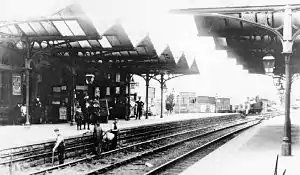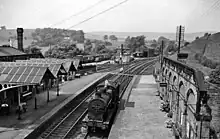Bakewell | |
|---|---|
 The station in 1905 | |
| General information | |
| Location | Bakewell, Derbyshire Dales England |
| Coordinates | 53°13′04″N 1°40′08″W / 53.2177°N 1.6689°W |
| Platforms | 2 |
| Other information | |
| Status | Disused |
| History | |
| Original company | Midland Railway |
| Pre-grouping | Midland Railway |
| Post-grouping | London Midland and Scottish Railway |
| Key dates | |
| 1 August 1862 | Station opened |
| 6 March 1967 | Station closed[1] |
Listed Building – Grade II | |
| Feature | Former Bakewell Railway Station |
| Designated | 28 January 1994 |
| Reference no. | 1316505[2] |
Bakewell railway station was a railway station built to serve the town of Bakewell in Derbyshire, England, by the Midland Railway on its extension of the Manchester, Buxton, Matlock and Midland Junction Railway line from Rowsley to Buxton.


Monsal Trail | |||||||||||||||||||||||||||||||||||||||||||||||||||||||||||||||||||||||||||||||||||||||||||||||||||||||||||||||||||||||||||||||||||||||||||||||||||||||||||
|---|---|---|---|---|---|---|---|---|---|---|---|---|---|---|---|---|---|---|---|---|---|---|---|---|---|---|---|---|---|---|---|---|---|---|---|---|---|---|---|---|---|---|---|---|---|---|---|---|---|---|---|---|---|---|---|---|---|---|---|---|---|---|---|---|---|---|---|---|---|---|---|---|---|---|---|---|---|---|---|---|---|---|---|---|---|---|---|---|---|---|---|---|---|---|---|---|---|---|---|---|---|---|---|---|---|---|---|---|---|---|---|---|---|---|---|---|---|---|---|---|---|---|---|---|---|---|---|---|---|---|---|---|---|---|---|---|---|---|---|---|---|---|---|---|---|---|---|---|---|---|---|---|---|---|---|
| |||||||||||||||||||||||||||||||||||||||||||||||||||||||||||||||||||||||||||||||||||||||||||||||||||||||||||||||||||||||||||||||||||||||||||||||||||||||||||
| Sources[3][4] | |||||||||||||||||||||||||||||||||||||||||||||||||||||||||||||||||||||||||||||||||||||||||||||||||||||||||||||||||||||||||||||||||||||||||||||||||||||||||||
History
The station was opened by the Midland Railway on 1 August 1862.[1] Being the nearest station to Haddon Hall, it was built in a grand style as the local station for the Duke of Rutland over whose land the line had passed. Designed by Edward Walters of Manchester, the buildings were of fine ashlar with intricate carvings which incorporated the duke's coat of arms.
Since the line was climbing steeply towards its summit at Peak Forest, the station was located uphill about half a mile from the town, which became a disadvantage when road transport developed.
The busiest time was during the Bakewell Show but the station was also popular with campers and tourists. The station was host to an LMS caravan from 1935 to 1939. A camping coach was also positioned here by the London Midland Region from 1954 to 1967.[5][6]
In the Grouping of all lines (into four main companies) in 1923 the station became part of the London, Midland and Scottish Railway.
During the nationalisation of Britain's railways in 1948 the station was passed on to the London Midland Region of British Railways, and despite escaping the Beeching Axe the station was closed when passenger services ceased on 6 March 1967.[1] Trains continued to pass through the station until 1968 when the line was closed.
Stationmasters
- John Tomlinson 1862[7]–1873
- Alfred Fewkes 1873–1880[8]
- George R. Gardner 1880–1891[9]
- Albert C. Bilham 1891–1898 (afterwards stationmaster at Matlock Bath)
- Thomas Pitt 1898–1901[10] (formerly stationmaster at Rowsley)
- Frank Porter 1901–1907 (formerly stationmaster at Spondon)
- Harry l’Anson 1907–1911 (formerly stationmaster at Grindleford, afterwards stationmaster at Matlock)
- Harry S. Dawes 1911–1922 (formerly stationmaster at Whatstandwell)[11]
- Ernest Clowes 1922[12]–1932 (formerly stationmaster at Hathern)
- E. Miles from 1932
After closure
The station buildings still survive and are Grade II listed.[2] They are perched half a mile east of the centre of Bakewell, high upon the hillside due to the alignment that the railway was forced to take.
In time the station was replaced with Bakewell Industrial Estate; the station building is still in use as a warehouse along with the platforms (but the gap between platforms have been filled in to facilitate the Monsal Trail).
Ridged canopies existed over platform 1, and there was a goods shed and cattle dock, but all have since been removed.
See also
References
- 1 2 3 Butt 1995, p. 23
- 1 2 Historic England. "Former Bakewell Railway Station (Grade II) (1316505)". National Heritage List for England. Retrieved 26 March 2019.
- ↑ "The Monsal Trail". A Taste of the Peak District. Retrieved 10 April 2020.
- ↑ Bickerdike, Graeme (June 2009). "The story of structures of the Monsal Trail: A Week in the Peak". Retrieved 10 April 2020.
- ↑ Kingscott, Geoffrey (2007). Lost Railways of Derbyshire. Newbury: Countryside Books. ISBN 9781846740428.
- ↑ McRae 1997, pages 22 & 50
- ↑ "1859-1866". Midland Railway Miscellaneous Depts: 83. 1914. Retrieved 12 February 2021.
- ↑ "Bakewell. Death of the Station-master". Derbyshire Courier. England. 13 March 1880. Retrieved 13 February 2021 – via British Newspaper Archive.
- ↑ "Death of the Bakewell Station-master". Derbyshire Times and Chesterfield Herald. England. 10 January 1891. Retrieved 13 February 2021 – via British Newspaper Archive.
- ↑ "Bakewell's late Stationmaster". Derbyshire Times and Chesterfield Herald. England. 1 February 1902. Retrieved 13 February 2021 – via British Newspaper Archive.
- ↑ "New Stationmaster for Bakewell". Derbyshire Courier. England. 23 May 1911. Retrieved 13 February 2021 – via British Newspaper Archive.
- ↑ "Midland Railway. Bakewell's new Stationmaster". Derbyshire Advertiser and Journal. England. 23 May 1911. Retrieved 13 February 2021 – via British Newspaper Archive.
Bibliography
- Butt, R. V. J. (October 1995). The Directory of Railway Stations: details every public and private passenger station, halt, platform and stopping place, past and present (1st ed.). Sparkford: Patrick Stephens Ltd. ISBN 978-1-85260-508-7. OCLC 60251199. OL 11956311M.
- McRae, Andrew (1997). British Railway Camping Coach Holidays: The 1930s & British Railways (London Midland Region). Vol. Scenes from the Past: 30 (Part One). Foxline. ISBN 1-870119-48-7.
Further reading
- Jowett, Alan (2000). Jowett's Nationalised Railway Atlas (1st ed.). Penryn, Cornwall: Atlantic Transport Publishers. ISBN 978-0-906899-99-1. OCLC 228266687.
- Jowett, Alan (March 1989). Jowett's Railway Atlas of Great Britain and Ireland: From Pre-Grouping to the Present Day (1st ed.). Sparkford: Patrick Stephens Ltd. ISBN 978-1-85260-086-0. OCLC 22311137.
- Station on navigable O.S. map
- Truman, P.; Hunt, D. (1989). Midland Railway Portrait. Sheffield: Platform 5 Publishing. ISBN 0906579724.
- Radford, B. (1988). Midland Through the Peak: A Pictorial History of the Midland Railway Main Line Routes Between Derby and Manchester. Unicorn Books. ISBN 1852410019.
External links
| Preceding station | Disused railways | Following station | ||
|---|---|---|---|---|
| Rowsley Line and station closed |
Midland Railway Manchester, Buxton, Matlock and Midland Junction Railway |
Hassop Line and station closed | ||
| Rowsley | Peak Rail | Terminus | ||